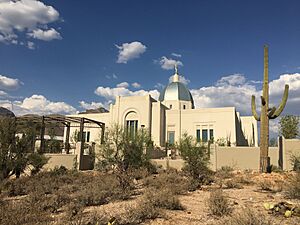Catalina Foothills, Arizona facts for kids
Quick facts for kids
Catalina Foothills, Arizona
|
|
|---|---|
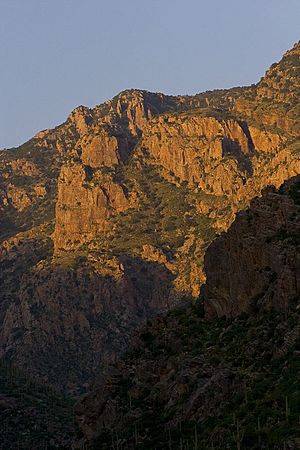
|
|
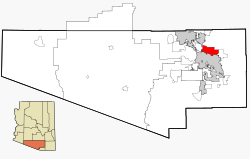
Location in Pima County and the state of Arizona
|
|
| Country | United States |
| State | Arizona |
| County | Pima |
| Area | |
| • Total | 41.92 sq mi (108.58 km2) |
| • Land | 41.85 sq mi (108.38 km2) |
| • Water | 0.08 sq mi (0.20 km2) |
| Elevation | 2,575 ft (785 m) |
| Population
(2020)
|
|
| • Total | 52,401 |
| • Density | 1,252.23/sq mi (483.49/km2) |
| Time zone | UTC-7 (MST (no DST)) |
| FIPS code | 04-11230 |
| GNIS feature ID | 37214 |
Catalina Foothills is a special kind of community called a census-designated place (CDP). It's located just north of Tucson, Arizona in Pima County, Arizona, United States. This area sits in the southern hills of the Santa Catalina Mountains. In 2020, about 52,401 people lived here.
Contents
History of Catalina Foothills
The story of modern Catalina Foothills began in the early 1920s. Before that, the land was mostly federal land used for cattle grazing. A man named John Murphey started buying land in the foothills of the Santa Catalina Mountains.
Murphey wanted to create a community with large housing lots. His idea was to have homes spread out, giving people lots of privacy. He also wanted to protect the natural desert plants, the land, and the beautiful mountain views. In 1928, Murphey bought a huge piece of land, about 7,000 acres (28 km²).
Around the same time, Josias Joesler, an architect from Switzerland, joined Murphey's project. Homes started to be built in the 1930s, and Joesler designed many of them.
In 1931, the people living in the Foothills created the Catalina Foothills School District. Murphey sold them the land for the first school building. Joesler designed this building, which is still used today for the school district's offices.
In 1936, Joesler and Murphey finished building St. Philip’s in the Hills Episcopal Church. This church is known for its beautiful Spanish Colonial Mission style. Murphey gave the land for the church, and Joesler designed it for free.
The Catalina Foothills continued to grow over the years. More neighborhoods were built, and in 1963, the Skyline Country Club opened. Later, in the 1980s, large resorts like La Paloma Resort and Ventana Canyon Resort were built. Even with many people living there, most neighborhoods in Catalina Foothills still feel open and spread out.
Geography of Catalina Foothills
Catalina Foothills is located at 32.293990 degrees North and -110.883872 degrees West.
The area covers about 44.6 square miles (115.5 km²). Most of this area, about 44.5 square miles (115.2 km²), is land. A very small part, about 0.1 square miles (0.3 km²), is water.
Population of Catalina Foothills
| Historical population | |||
|---|---|---|---|
| Census | Pop. | %± | |
| 2000 | 53,794 | — | |
| 2010 | 50,796 | −5.6% | |
| 2020 | 52,401 | 3.2% | |
| U.S. Decennial Census | |||
In 2000, there were about 53,794 people living in Catalina Foothills. By 2020, the population grew to 52,401.
Many different kinds of families live here. About 24.6% of households had children under 18. The average age of people living here was 45 years old.
Fun Things to Do in Catalina Foothills
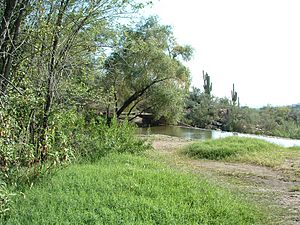
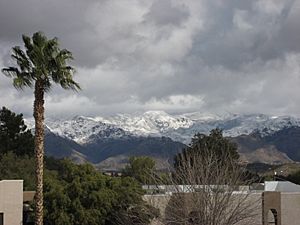
The Santa Catalina Mountains offer many cool places to explore, including:
There are also several fancy resorts in the area, like Hacienda del Sol Resort and Westin La Paloma Resort.
You can visit the DeGrazia Gallery in the Sun. This unique place was built by artist Ted DeGrazia starting in 1951. It has an interesting chapel, an art gallery, and a free museum. It's listed on the National Register of Historic Places.
If you like shopping, La Encantada is the biggest upscale shopping center in the Tucson area.
Catalina Foothills also has a unique neighborhood called Sin Vacas, which means "Without Cows" in Spanish. The land used to belong to a man who loved desert wildlife. He fenced his property to keep cows out, calling it "Rancho Sin Vacas."
The Tucson Arizona Temple of the Church of Jesus Christ of Latter-day Saints is also located in Catalina Foothills. It was finished in 2017.
Schools in Catalina Foothills
Catalina Foothills has three main public school districts that serve its students:
- Catalina Foothills Unified School District
- Tucson Unified School District
- Amphitheater Public Schools (also known as Amphitheater Unified School District)
Each district serves different parts of the Catalina Foothills area. For example, Catalina Foothills USD serves the upper parts, while Tucson USD serves the lower and northeastern neighborhoods. Amphitheater USD serves areas in the western Catalina Foothills.
See also
 In Spanish: Catalina Foothills (Arizona) para niños
In Spanish: Catalina Foothills (Arizona) para niños



